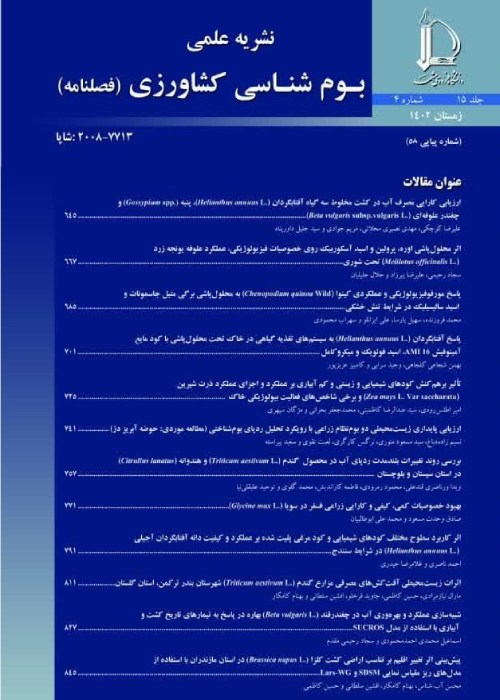The Effect of Planting Method and Sugarcane (Saccharum officinarum L.) Residue Compost on Yield and Yield Components of Corn (Zea mays L.) and some Properties of Soil
One of the factors affecting the growth and development of crops is the cultivation pattern, which affects the distribution of plants in the field, distances between plants, the use of growth sources such as light, water and soil nutrients, and competition between plants. These factors affect the growth and yield of crops. Also, using compost fertilizer has beneficial effects on physical, chemical and biological conditions of the soil and has positive effects on grain yield and yield components of crop plants. This study designed and carried out with aim to study the effect of planting method and sugarcane residue compost fertilizer on yield and yield components of corn and some soil properties in Ahwaz weather conditions at Agricultural Sciences and Natural Resources University of Khuzestan.
In order to investigate the effect of planting method and sugarcane residue compost fertilizer on yield and yield components of corn (hybrid of single cross 703) and some soil properties, a field experiment using a split-plot arrangement accomplished based on the randomized complete block design with four replications in Mian-Ab region of Shooshtar on 2018. Experimental factors were include four planting method (single row on ridges, on watermark, in furrows and on flat ground) as a main factor in main plots and four amounts of sugarcane residues compost (0, 10, 20 and 30 t ha-1) as a sub factor in sub-plots. Each sub-plot had 6 planting rows with a length of 3 meters and a width of 4.5 meters (with an area of 13.5 square meters). The seeds were planted manually at a depth of 3 cm at 2nd August 2017 with a density of 66000 per ha (the distance between ridges and furrows was 75 cm and the distance between the plants was 18 cm). In this experiment row number per ear, grains per row, thousand grain weight, grain yield, biological yield, harvest index, soil nitrogen percent and soil organic matter percent were measured.
The analysis of variance showed that the effect of plant method, sugarcane residue compost and their interaction were significant on the traits of row number per ear, grain number per row, thousand grain weight, grain yield, biological yield, harvest index, soil nitrogen percent and soil organic matter percent. The comparison of mean showed that the maximum amount of corn traits were obtained in furrow planting and using 30 t ha-1 of sugarcane residue compost and the lowest amounts were observed in ridge planting and non-use of sugarcane residue compost. So that, mean comparison of grain yield under the interaction of planting method and sugarcane residue compost showed that the highest grain yield (6497 kg ha-1) was in furrow planting and 30 t ha- of sugarcane residue compost and the lowest grain yield (3870 kg ha-1) was in ridge planting and non-use of sugarcane residue compost. Examination of correlation coefficients between the measured traits showed that grain yield had a more positive and significant correlation with biological yield, harvest index and 1000-grain weight. Also, biological yield had a more positive and significant correlation with grain yield, 1000-seed weight and number of rows per ear.
In general, the findings of this experiment demonstrated that the furrow cultivation method resulted in the highest values for the measured traits (excluding soil nitrogen and soil organic matter percentage). Moreover, across all cultivation methods, an increase in the application of sugarcane residues compost fertilizer, as well as the availability of water and nutrients for the plants, led to an increase in the magnitude of these traits. The maximum values were achieved at a compost fertilizer rate of 30 t ha-1. Based on the results of this experiment, it can be concluded that cultivating corn using the furrow method and applying 20 to 30 t ha-1 of sugarcane residue compost can significantly enhance corn grain yield in the Shooshtar region.
- حق عضویت دریافتی صرف حمایت از نشریات عضو و نگهداری، تکمیل و توسعه مگیران میشود.
- پرداخت حق اشتراک و دانلود مقالات اجازه بازنشر آن در سایر رسانههای چاپی و دیجیتال را به کاربر نمیدهد.




